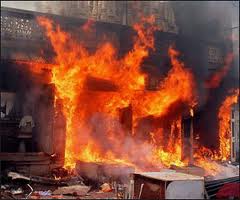
To begin with the burning of Sabarmati S 6 coach was cleverly projected to be an act done by neighboring Muslims and in turn the violence was directed against the Muslim population of Gujarat, on the ground that the Hindu sentiments are hurt. The section of Hindu community was deliberately incited by the decision of state to take the burnt bodies of victims in a procession, against the advice of the collector of the city. The Bandh call given by VHP created the ground for violence. Here the social engineering was at its display, and dalits and Adivasis were mobilized to unleash the violence against the hapless innocent Muslims, accompanied by the propaganda which demonized the Muslim community as a whole. While in earlier acts of violence, the state police have been an accomplice and the silent onlooker to the violence, here a sort of active collusion of state machinery and the communal forces was on display.
The BJP ruled state Government had unrestricted run in the state as the Central Government was being ruled by BJP led NDA and the other allies of BJP were too enamored by the spoils of power to spoil the broth by speaking out. Modi had already instructed the officials to sit back when the Hindu backlash will take place. The leading light of socialist movement, George Fernandez, went to the extent of taking the violence against minority women in the stride by saying that rape is nothing new and it happens in such situations. What more was needed for the rioters to run amuck and to central BJP leadership to let the things go on. The pattern of violence against women was particularly horrific, targeting at their reproductive organs and shaming them to no end.
While the architect of Gujarat pogrom Narnedra Modi kept saying that violence has bee controlled in three days, and central BJP leadership patted him for this, the matter of fact was that violence went on and on painfully for a long time, uncontrolled and unrestricted. The attitude of the BJP controlled state was pathetic and showed the religious bias in relief and rehabilitation work. The compensations given to minorities were abysmally low, state quickly retreated from the refugee camps on the ground that the refugee camps are ‘child production centers’, hitting the minorities where it hurts most. The biases against them were on full display. The atmosphere was created by communal forces in such a manner that the riot victims could not go back to their houses as the people in their areas demanded a written undertaking from them, that they will withdraw the cases filed in the context of violence and that they will not file any cases. Most of the police as machinery either refused to file the FIRs or if registered they kept enough loopholes for the criminals to get away. It was in this atmosphere that the process of getting justice became a close to impossible task. The communalized state apparatus, the attitude of police and judiciary led the Supreme court to direct the shifting of cases away from Gujarat.
The investigation against Narendra Modi by the state police was an impossible task and so the Special Investigation team was constituted. Unfortunately, that also did not help the matters. Accompanying all this violence and attitude of state government the minorities started feeling extremely insecure. They were boycotted in trade and other social spaces. The result is the sprawling slum of Juhapura as the symbol of polarization of communities along the religious lines. The total dislocation of the monitories created multiple problems at the level of education and sources of livelihood for the minorities.
The religious polarization and section of media has created a Halo around Narendra Modi, while strictures against him are coming by, about his failure to protect places of religious worship of minorities, the malafide intentions of state in filing cases against social activist Teesta Setalvad, many another cases are still pending, crying for justice for the victims of Gujarat. Having consolidated the section of majority community behind him, assured of their ongoing support, Modi started the high profile propaganda about development and has been trying to distract the attention from the havoc which he has wrought in the state. The big capitalists are finding the state of Gujarat as a happy hunting ground for massive state subsidies, so the media controlled by them is singing praises and modulating popular opinion in his favor, creating a larger than life size image, development man, in order to suppress his role in the violence against minorities.
In this dismal scenario, there have been many an examples of victims and social activists standing for the cause of justice and doing the practically impossible task of getting justice for violence victims despite all the efforts to turn them hostile and protect the guilty of the communal crimes. While the massive propaganda and state policies are trying to turn the minorities into second class citizens, there are efforts which have gone on simultaneously to retrieve the democratic values in the face of such adverse intimidating situation created by the communal forces. Lately, apart from Court judgments, the civil society response has been picking up and the civil society is trying to overcome the stifling situation and trying to make its voice louder. While we are nowhere close to what should ideally be there in a democratic set up, the responses of civil society and social action groups are noteworthy in the matters of getting justice for victims and in the matters of recreating the liberal space which has been undermined by the communal forces. Times alone will tell if democratic values will be successfully brought in this ‘Hindu Rashtra in one state’






Comments
Add new comment